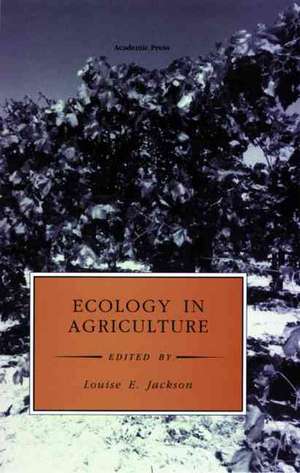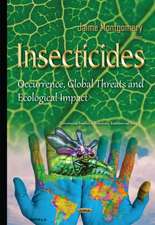Ecology in Agriculture: Physiological Ecology
Editat de Louise E. Jacksonen Limba Engleză Hardback – 13 sep 1997
Ecology in Agriculture focuses exclusively on the ecology of agricultural ecosystems. The book is divided into four major sections. An introduction establishes the unique ties between agricultural and ecological sciences. The second section describes the community ecology of these sorts of ecosystems, while the final section focuses on the processes that operate throughout these agricultural landscapes.
- Contains an ecological perspective on agricultural production and resource utilization
- Includes in-depth reviews of major issues in crop ecology by active researchers
- Covers a range of topics in agricultural ecophysiology, community ecology, and ecosystems ecology
- Provides examples of ecological approaches to solving problems in crop management and environmental quality
Preț: 441.32 lei
Preț vechi: 627.71 lei
-30% Nou
Puncte Express: 662
Preț estimativ în valută:
84.45€ • 92.02$ • 71.16£
84.45€ • 92.02$ • 71.16£
Carte tipărită la comandă
Livrare economică 16-30 aprilie
Preluare comenzi: 021 569.72.76
Specificații
ISBN-13: 9780123782601
ISBN-10: 0123782600
Pagini: 472
Dimensiuni: 152 x 229 x 28 mm
Greutate: 0.79 kg
Editura: ELSEVIER SCIENCE
Seria Physiological Ecology
ISBN-10: 0123782600
Pagini: 472
Dimensiuni: 152 x 229 x 28 mm
Greutate: 0.79 kg
Editura: ELSEVIER SCIENCE
Seria Physiological Ecology
Public țintă
Advanced undergraduates, graduate students, faculty and researchers in ecology, agronomy, plant sciences, forestry and related agricultural disciplines, libraries.Cuprins
Plant Responses to their Environment:
L.E. Jackson and G. Koch, The Ecophysiology of Crops and their Wild Relatives.
V.P. Gutshick, Photosynthesis, Growth Rate, and Biomass Allocation.
A.G. Condon and A.E.Hall, Adaptation to Diverse Agricultural Environments: Genotypic Variation in Water Use Efficiency with Crop Series.
C-G. Padilla, E. Fereres, and F. Orgaz, Productivity in Water-Limited Environments: Crop Responses and Management of Dryland Agricultural Systems.
A.J. Bloom, Nitrogen as a Limiting Factor: Crop Acquisition of Ammonium and Nitrate.
D.M. Eissenstat, Tradeoffs in Root Form and Function. Biotic Interactions and Processes:
M.R. Finckh and M.S. Wolfe, The Use of Biodiversity to Restrict Plant Diseases and Some Consequences for Farmers and Society.
D.K. Letourneau, Plant-Arthropod Interactions in Agroecosystems.
M. Liebmann and E.R. Gallandt, Many Little Hammers: Ecological Approaches for Management of Crop-Weed Interactions.
G.P. Robertson, Nitrogen Use Efficiency in Row-Crop Agriculture: Crop Nitrogen Use and Soil Nitrogen Loss.
K.M. Scow, Interrelationships between Soil Microbial Communities and Carbon Flow in Agroecosystems.
R. Leemans, Effects of Global change on Agricultural Land Use: Scaling Up from Physiological Processes to Ecosystem Dynamics.
L.E. Jackson and G. Koch, The Ecophysiology of Crops and their Wild Relatives.
V.P. Gutshick, Photosynthesis, Growth Rate, and Biomass Allocation.
A.G. Condon and A.E.Hall, Adaptation to Diverse Agricultural Environments: Genotypic Variation in Water Use Efficiency with Crop Series.
C-G. Padilla, E. Fereres, and F. Orgaz, Productivity in Water-Limited Environments: Crop Responses and Management of Dryland Agricultural Systems.
A.J. Bloom, Nitrogen as a Limiting Factor: Crop Acquisition of Ammonium and Nitrate.
D.M. Eissenstat, Tradeoffs in Root Form and Function. Biotic Interactions and Processes:
M.R. Finckh and M.S. Wolfe, The Use of Biodiversity to Restrict Plant Diseases and Some Consequences for Farmers and Society.
D.K. Letourneau, Plant-Arthropod Interactions in Agroecosystems.
M. Liebmann and E.R. Gallandt, Many Little Hammers: Ecological Approaches for Management of Crop-Weed Interactions.
G.P. Robertson, Nitrogen Use Efficiency in Row-Crop Agriculture: Crop Nitrogen Use and Soil Nitrogen Loss.
K.M. Scow, Interrelationships between Soil Microbial Communities and Carbon Flow in Agroecosystems.
R. Leemans, Effects of Global change on Agricultural Land Use: Scaling Up from Physiological Processes to Ecosystem Dynamics.
Recenzii
"The editor and contributors have done an admirable job covering the three levels of ecological/agricultural interactions. Recommended highly for libraries maintaining agricultural, ecological, and horticultural collections." --Choice
"...a real benefit of this book will be for professionals seeking an up-to-date synopsis of current research, as the text is immensely detailed, very fully referenced and supported with appropriate data. Ecologists, agronomists and crop scientists will find this book an asset to have on their shelves for reference. Overall, a very laudable collection of papers spanning both ecology and agronomy, which should provide a useful resource for new and current practitioners." --Biological Journal of The Linnean Society
"The editor has provided a text which will stimulate discussion within the agricultural industry. Individuals who may benefit from reading this book include researchers, teachers, and students." --The Canadian Field-Naturalist, 1999
"...a real benefit of this book will be for professionals seeking an up-to-date synopsis of current research, as the text is immensely detailed, very fully referenced and supported with appropriate data. Ecologists, agronomists and crop scientists will find this book an asset to have on their shelves for reference. Overall, a very laudable collection of papers spanning both ecology and agronomy, which should provide a useful resource for new and current practitioners." --Biological Journal of The Linnean Society
"The editor has provided a text which will stimulate discussion within the agricultural industry. Individuals who may benefit from reading this book include researchers, teachers, and students." --The Canadian Field-Naturalist, 1999






















